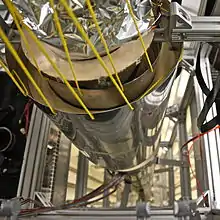Atomic fountain
An atomic fountain is a cloud of atoms that is tossed upwards in the Earth's gravitational field by lasers. If it were visible, it would resemble the water in a fountain. While weightless in the toss, the atoms are measured to set the frequency of an atomic clock.[1]

The primary motivation behind the development of the atomic fountain derives from the Ramsey method of measuring the frequency of atomic transitions.[2] In broad strokes, the Ramsey method involves exposing a cloud of atoms to a brief radiofrequency (rf) electromagnetic field; waiting a time T; briefly exposing the cloud to the rf field again; and then measuring what fraction of the atoms in the cloud have transitioned.[2] If the frequency of the rf field is identical to the atomic transition frequency, 100% of the atoms will have transitioned; if the frequency of the field differs slightly from the transition frequency, some of the atoms will not have transitioned.[2] By repeatedly sending clouds of atoms through such an apparatus, the frequency of the field can be adjusted to match the atomic transition frequency.[3]
The precision of the Ramsey method can be increased by increasing the wait time T of the cloud.[2] The use of an atomic fountain with a cooled atomic cloud allows for wait times on the order of one second, which is vastly greater than what can be achieved by performing the Ramsey method on a hot atomic beam.[2] This is one reason why NIST-F1, a caesium fountain clock, can keep time more precisely than NIST-7, a caesium beam clock.[1]
History
The idea of the atomic fountain was first proposed in the 1950s by Jerrold Zacharias.[4] Zacharias attempted to implement an atomic fountain using a thermal beam of atoms, under the assumption that the atoms at the low-velocity end of the Maxwell–Boltzmann distribution would be of sufficiently low energy to execute a reasonably sized parabolic trajectory.[5] However, the attempt was not successful because fast atoms in a thermal beam struck the low-velocity atoms and scattered them.[5]
References
- https://www.nist.gov/public_affairs/releases/n99-22.cfm How the NIST-F1 Caesium Fountain Clock Works
- C. J. Foot (2005). Atomic Physics. p. 212.
- "NIST Launches a New U.S. Time Standard: NIST-F2 Atomic Clock" on YouTube
- M. A. Kasevich; et al. (1989). "Atomic fountains and clocks". Optics News. 15 (12): 31–32.
- S. Chu (1998). "The manipulation of neutral particles" (PDF). Rev. Mod. Phys. 70: 685–706. Bibcode:1998RvMP...70..685C. doi:10.1103/RevModPhys.70.685.
External links